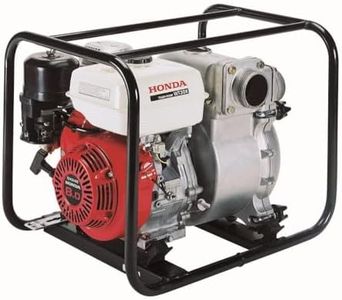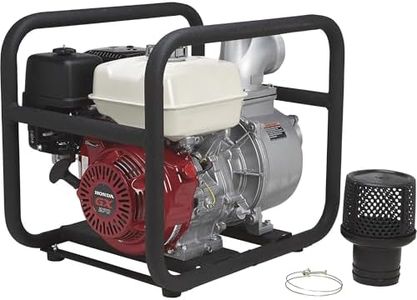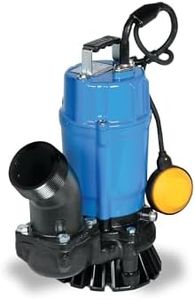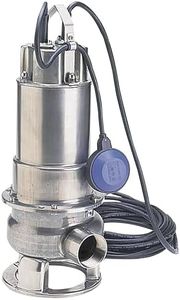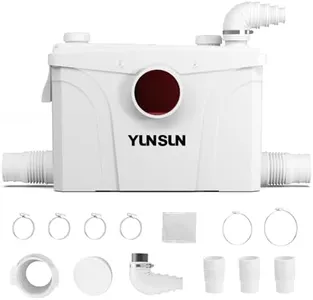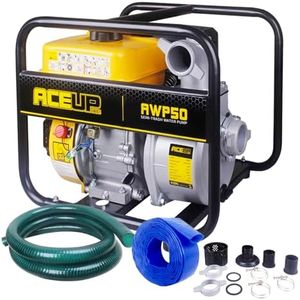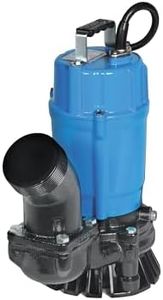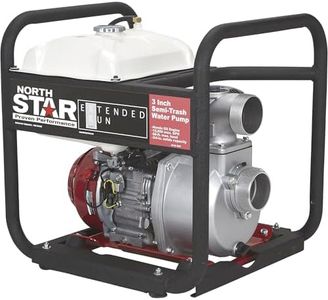10 Best Trash Pump 2025 in the United States
Our technology thoroughly searches through the online shopping world, reviewing hundreds of sites. We then process and analyze this information, updating in real-time to bring you the latest top-rated products. This way, you always get the best and most current options available.

Our Top Picks
Winner
Honda WT30 Heavy Duty Trash Pump, 3" 658190
Most important from
3 reviews
The Honda WT30 Heavy Duty Trash Pump is a solid choice if you need a reliable pump to move dirty water containing solids. It can handle up to 319 gallons per minute, which is a good flow rate for many cleanup jobs. The pump can move solids up to about 1 inch in size, making it suitable for tasks that involve some debris but not large chunks. Powered by an easy-starting Honda gas engine, it offers dependable performance and is fueled by gas, which means you don’t have to worry about finding electric power on site.
Its cast iron volute and impeller add durability, although the pump’s body is made of aluminum, balancing strength with lighter weight. Weighing 134 pounds and with dimensions that make it somewhat bulky, it’s portable but may require effort or a cart to move around easily. The quick clean out port is convenient for maintenance, helping save time during work.
A possible downside is the weight if you plan frequent transport or need something very lightweight. Also, it’s designed more for medium-duty debris, so if you need to move larger solids, this might not be the best fit. For users needing a dependable, gas-powered trash pump that balances power, durability, and moderate portability, the Honda WT30 is a reliable option.
Most important from
3 reviews
NorthStar Semi-Trash Pump-4in Ports 23,040 GPH 3/4in Solids Cap #109183
Most important from
11 reviews
The NorthStar Semi-Trash Pump is a robust option for those needing a reliable water pump for handling semi-trash operations. With a high flow rate of 23,040 gallons per hour (GPH), it is capable of moving a large volume of water efficiently. The pump can handle solid particles up to 3/4 inches in diameter, making it suitable for jobs where debris might be present. The cast iron impeller and volute enhance its durability, ensuring a long lifespan even under tough conditions. Additionally, the silicon carbide mechanical seals provide excellent resistance to corrosion, wear, and heat, outperforming standard seals significantly. This feature ensures the pump remains functional and reliable over time.
The 23-foot maximum suction lift is decent, allowing for flexibility in various pumping scenarios. However, weighing in at 119 pounds, it may not be the most portable option for users who need to move it frequently. Another limitation is the power source, which is wind-powered. This might not be practical for all users, especially those requiring a more consistent and controllable fuel type like gasoline or diesel. The cast iron material and black color give it a sturdy and professional appearance.
In summary, the NorthStar Semi-Trash Pump is a durable and high-performing option best suited for semi-trash operations where portability is not a primary concern, and a wind-powered source is acceptable.
Most important from
11 reviews
Tsurumi Pump HS2.4S Submersible Trash Pump with Agitator 1/2 HP 115V 2 in Discharge Ideal for dewatering applications with sand, solids, and other debris | 39 GPM / 2340 GPH
Most important from
589 reviews
The Tsurumi Pump HS2.4S is a sturdy submersible trash pump designed for dewatering applications involving sand, solids, and debris. With a flow rate of 53 gallons per minute (GPM) and the capability to handle debris up to 0.3 inches in size, this pump is efficient for various demanding scenarios. The 1/2 horsepower motor provides reliable and robust performance, making it suitable for construction sites and disaster remediation.
Operating on a standard 115V power supply, it ensures compatibility with common electrical setups. The aluminum construction enhances durability while keeping the weight manageable at 29.1 pounds, facilitating portability despite being corded electric. The integrated agitator and semi-vortex impeller design minimize wear and clogging, contributing to the pump's longevity.
The 2-inch angled discharge port offers flexibility in hose and fitting setups, further boosting productivity. However, the electric power source limits its use to locations with access to power outlets, which might be a drawback in remote areas. The 20ft cord provides some flexibility but may still require extensions depending on the site. Tsurumi's 2-year warranty and certifications (UL & CSA) add assurance of quality and reliability. This pump is ideal for users needing a durable, high-capacity solution for tough dewatering tasks.
Most important from
589 reviews
Buying Guide for the Best Trash Pump
Choosing the right trash pump can make a significant difference in handling water with debris, such as in construction sites, agricultural fields, or flood-prone areas. A trash pump is designed to move water that contains solids like leaves, twigs, sand, and other debris. To select the best trash pump for your needs, you should consider several key specifications that will determine the pump's performance and suitability for your specific application.FAQ
Most Popular Categories Right Now
